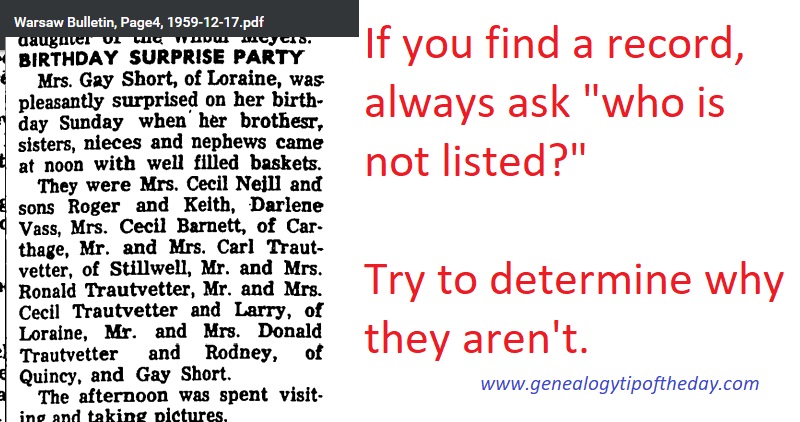In any record or genealogical reference that lists a group of relatives or family members, determine if there are individuals who should be there who are not.

Sometimes this is easier to do that others, but it’s still a good exercise. The 1959 reference in the illustration is to a birthday party where siblings and nieces and nephews birthday celebrant were in attendance. The newspaper lists two individuals as “Mrs.” with no “Mr.” listed. In one case, the husband was deceased. In the other case, he was not (it’s not known why he did not attend). I also made certain that there were no other siblings of the celebrant besides the ones listed. One guest was actually the girlfriend of one of the nephews but that is not stated. The celebrant’s husband attended as well, but his name is listed last.
Never assume a list is complete. And if you realize that there are people who should be listed and are not, add that comment to the item when including it in your genealogical database.
Help support Genealogy Tip of the Day by visiting any of the following sites:
- Try a GenealogyBank Genealogy Search to see what you find.
- Newspapers.com
- AncestryDNA offers
- Books on Michael’s Genealogy Shelf








One response
My great grandfather didn’t leave a will, but his estate was administered and in the estate papers all but one of his surviving children (or their heirs) was accounted for. The excluded daughter had a actually died shortly before her father did, in his own house, and is said to be buried on the family farm but has no headstone. she left a husband and one child who lived to adulthood and had children of her own. My thought is that the family felt that her share of the estate had gone to pay for her care in her last days, or maybe there were loans that they knew would never be collected. If her father had lived longer he would probably have put up a headstone for her. I only knew about her own daughter from a nice photo of her as a young woman in my mother’s scrapbook.